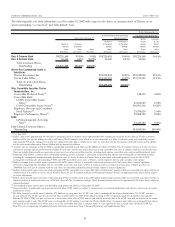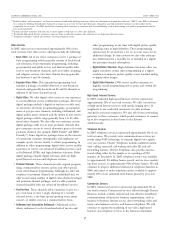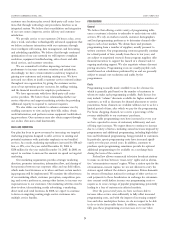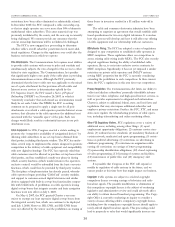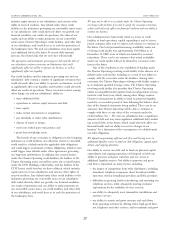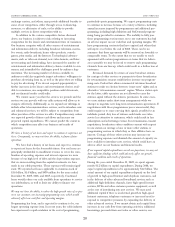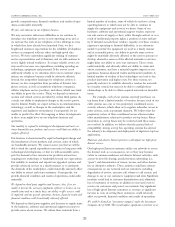Charter 2007 Annual Report Download - page 25
Download and view the complete annual report
Please find page 25 of the 2007 Charter annual report below. You can navigate through the pages in the report by either clicking on the pages listed below, or by using the keyword search tool below to find specific information within the annual report.
restrictions have been either eliminated or substantially relaxed.
In December 2007, the FCC reimposed a cable ownership cap,
so that no single operator can serve more than 30% of domestic
multichannel video subscribers. This same numerical cap was
previously invalidated by the courts, and the new cap is currently
being challenged. We cannot provide any assurance that the
current ownership limitations will be invalidated if challenged.
The FCC is now engaged in a proceeding to determine
whether cable’s overall subscriber penetration levels merit addi-
tional regulations. Changes in this regulatory area could alter the
business environment in which we operate.
Pole Attachments. The Communications Act requires most utilities
to provide cable systems with access to poles and conduits and
simultaneously subjects the rates charged for this access to either
federal or state regulation. The Communications Act specifies
that significantly higher rates apply if the cable plant is providing
telecommunications services. Although the FCC previously
determined that the lower cable rate was applicable to the mixed
use of a pole attachment for the provision of both cable and
Internet access services (a determination upheld by the
U.S. Supreme Court), the FCC issued a Notice of Proposed
Rulemaking (“NPRM”) on November 20, 2007, in which it
“tentatively concludes” that such mixed use determination would
likely be set aside. Under this NPRM, the FCC is seeking
comment on its proposal to apply a single rate for all pole
attachments over which a cable operator provides Internet access
services, that allocates to the cable operators the additional cost
associated with the “unusable space” of the pole. Such rate
change would likely result in a substantial increase in our pole
attachment costs.
Cable Equipment. In 1996, Congress enacted a statute seeking to
promote the “competitive availability of navigational devices” by
allowing cable subscribers to use set-top boxes obtained from
third parties, including third-party retailers. The FCC has under-
taken several steps to implement this statute designed to promote
competition in the delivery of cable equipment and compatibility
with new digital technology. The FCC has expressly ruled that
cable customers must be allowed to purchase set-top boxes from
third parties, and has established a multi-year phase-in during
which security functions (which would remain in the operator’s
exclusive control) would be unbundled from the basic converter
functions, which could then be provided by third party vendors.
The first phase of implementation has already passed, whereby
cable operators began providing “CableCard” security modules
and support to customer-owned digital televisions and similar
devices equipped with built-in set-top box functionality compat-
ible with CableCards. A prohibition on cable operators leasing
digital set-top boxes that integrate security and basic navigation
functions went into effect on July 1, 2007.
On May 4, 2007, the FCC granted Charter a one-year
waiver to exempt our least expensive digital set-top boxes from
the integrated security ban, which can continue to be deployed
until July 1, 2008. However, HD, DVR, and HD/DVR boxes
were not affected by the waiver and the prohibition on leasing of
those boxes in inventory resulted in a $1 million write-off in
2007.
The cable and consumer electronics industries have been
attempting to negotiate an agreement that would establish addi-
tional specifications for two-way digital televisions. It is unclear
how this process will develop and how it will affect our offering
of cable equipment and our relationship with our customers.
MDUs/Inside Wiring. The FCC has adopted a series of regulations
designed to spur competition to established cable operators in
MDU complexes. These regulations allow our competitors to
access existing cable wiring inside MDUs. The FCC also recently
adopted regulations limiting the ability of established cable
operators, like us, to enter into exclusive service contracts for
MDU complexes. Significantly, it has not yet imposed a similar
restriction on private cable operators and SMATV systems
serving MDU properties but the FCC is currently considering
extending the prohibition to such competitors. In their current
form, the FCC’s regulations in this area favor our competitors.
Privacy Regulation. The Communications Act limits our ability to
collect and disclose subscribers’ personally identifiable informa-
tion for our video, telephone, and high-speed Internet services, as
well as provides requirements to safeguard such information.
Charter is subject to additional federal, state, and local laws and
regulations that may also impose additional subscriber and
employee privacy restrictions. Further, the FCC, FTC, and many
states now regulate the telemarketing practices of cable opera-
tors, including telemarketing and online marketing efforts.
Other FCC Regulatory Matters. FCC regulations cover a variety of
additional areas, including, among other things: (1) equal
employment opportunity obligations; (2) customer service stan-
dards; (3) technical service standards; (4) mandatory blackouts of
certain network, syndicated and sports programming; (5) restric-
tions on political advertising; (6) restrictions on advertising in
children’s programming; (7) restrictions on origination cable-
casting; (8) restrictions on carriage of lottery programming;
(9) sponsorship identification obligations; (10) closed captioning
of video programming; (11) licensing of systems and facilities;
(12) maintenance of public files; and (13) emergency alert
systems.
It is possible that Congress or the FCC will expand or
modify its regulation of cable systems in the future, and we
cannot predict at this time how that might impact our business.
Copyright. Cable systems are subject to a federal copyright
compulsory license covering carriage of television and radio
broadcast signals. The possible modification or elimination of
this compulsory copyright license is the subject of continuing
legislative and administrative review and could adversely affect
our ability to obtain desired broadcast programming. The Copy-
right Office is currently conducting an inquiry to consider a
variety of issues affecting cable’s compulsory copyright license,
including how the compulsory copyright license should apply to
newly-offered digital broadcast signals. This proceeding could
lead to proposals or rules that would significantly increase our
CHARTER COMMUNICATIONS, INC. 2007 FORM 10-K
14



